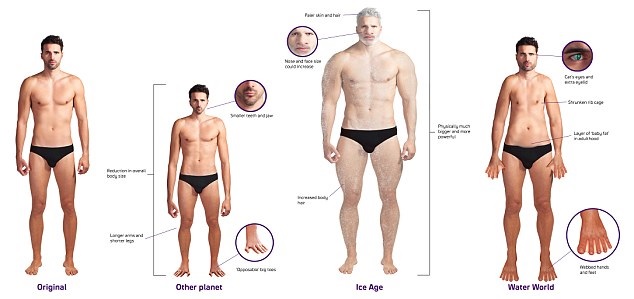Experts calculated how our physical appearance could change under a number of scenarios, including a 'water world' if melting ice caps cause rising sea levels.
They also considered what would happen in a second ice age which could be triggered by an asteroid strike, and if humans colonised other planets.
Experts calculated how our physical appearance could change under a number of scenarios, including a 'water world' if melting ice caps cause rising sea levels. They also considered what would happen in a second ice age. These artist's impressions show how women may evolve to develop webbed feet and hands and cat's eyes
Experts calculated how our physical appearance could change under a number of scenarios, including a 'water world' if melting ice caps cause rising sea levels. They also considered what would happen in a second ice age. These artist's impressions show how women may evolve to develop webbed feet and hands and cat's eyes
Dr Matthew Skinner, a paleoanthropologist at the University of Kent, examined the three scenarios and worked with artist Quentin Devine to help visualise how humans could look in the future.
Dr Skinner said some changes – such as webbed feet and hands becoming widespread – could take place very quickly as some humans already have a genetic mutation that produces webbing.
Other changes to allow humans to live in extreme conditions might only take place over hundreds of generations of natural selection, or require genetic engineering.
HOW WILL HUMANS EVOLVE
We would also retain a layer of baby fat into adulthood as an insulator for spending long periods submerged.
Regular foraging in shallow waters could lead us to develop artificial 'gills' to help us breathe, extracting oxygen from the water and delivering it to the bloodstream.
We might also evolve an extra translucent eyelid to protect the eyes from water.
In the scenario of an ice age, Dr Skinner predicts that our skin would become very pale to help us produce more vitamin D from less sunlight, we would have more body hair, and we would develop more muscular physiques.
Our noses and face size would increase to help warm inhaled cold air in the nasopharynx, the area behind the nose.
We would become stronger, as reduced resources and technologies would mean physical power becomes more important.
He said: 'We could genetically engineer ourselves if important enough to survive. Some of these things we might try to develop as a necessity rather than occurring over time naturally. Others could occur over tens of thousands of years.'
To adapt to a 'water world', Dr Skinner expects humans would develop webbed hands and eyes like those of cats to help us see in the poor lighting conditions underwater.
We would also retain a layer of baby fat into adulthood as an insulator for spending long periods submerged.
Regular foraging in shallow waters could lead us to develop artificial 'gills' to help us breathe, extracting oxygen from the water and delivering it to the bloodstream.
This would also lead to our lung capacity becoming greatly reduced, and our rib cages shrinking.
An additional layer in the retina - like cat's eyes - could develop to help us see in poor light under water. We might also evolve an extra translucent eyelid to protect the eyes from water.
In the scenario of an ice age, Dr Skinner predicts that our skin would become very pale to help us produce more vitamin D from less sunlight, we would have more body hair, and we would develop more muscular physiques.
Our noses and face size would increase to help warm inhaled cold air in the nasopharynx, the area behind the nose.
We would become stronger, as reduced resources and technologies would mean physical power becomes more important.
This would be particularly true for men, who would need to attract a mate through their physique rather than intellect, much like gorillas in the natural world.
Our noses and face size would increase to help warm inhaled cold air in the nasopharynx, the area behind the nose. We would become stronger, as reduced resources and technologies would mean physical power becomes more important. This would be particularly true for men (illustrated)
Our noses and face size would increase to help warm inhaled cold air in the nasopharynx, the area behind the nose. We would become stronger, as reduced resources and technologies would mean physical power becomes more important. This would be particularly true for men (illustrated)
MELTWATER IS MAKING SEAS RISE
The rate at which water is released from the Greenland ice sheet is accelerating, according to a multinational team of scientists.
Studying the upper layers of snow on the island's glaciers, they found the compacted snowy frosting on the ice cap, called firn, is losing its ability to absorb meltwater.
This is due to the formation of 'ice lenses' beneath the surface, indicating that the sponge-like ability of the firn to soak up melting surface water is being lost.
Experts fear this could lead to increased release of the meltwater into the oceans.
In a separate study, analysis of the loss of snow from the sheet revealed that cloudy skies are also accelerating the melting of the island's glaciers.
Even though clouds bring moisture to recharge the ice sheet through fresh snow fall, this effect is obliterated by the higher temperatures that also accompany cloudy weather.
Overall, the researchers found that glacier melting increased by a third in cloudy conditions.
The result is an additional 56 billion tonnes of meltwater reaching the oceans each year.
Females would also need to become physically stronger. Body hair would need to increase as a means of insulation.
And if we were to colonise other worlds, the body would need to undergo a variety of changes to adapt to low gravity.
These could include longer arms and shorter legs as in low gravity walking would be less necessary. Upper and lower limbs would become more important and become similar in length, as seen in orangutans, who swing through trees rather than walk.
We could develop 'opposable' big toes as our feet become more useful for gripping things in low gravity.
Dr Skinner said eventually there could be a complete loss of teeth and a reduction in jaw and mouth size down to something you can fit a straw into, which would result in our faces becoming smaller.
The overall effect would be to make us look more like newborn babies, whose mouths only need to swallow.
Having a lack of natural predators, humans' overall body size would reduce. This is seen in nature in a phenomenon called 'island dwarfing', where mammals have low resources available and few predators.
Dr Skinner produced his predictions as the new series of science fiction drama Extant is launched on the Syfy Channel this week.
How the human body could evolve to changing climates












No comments:
Post a Comment